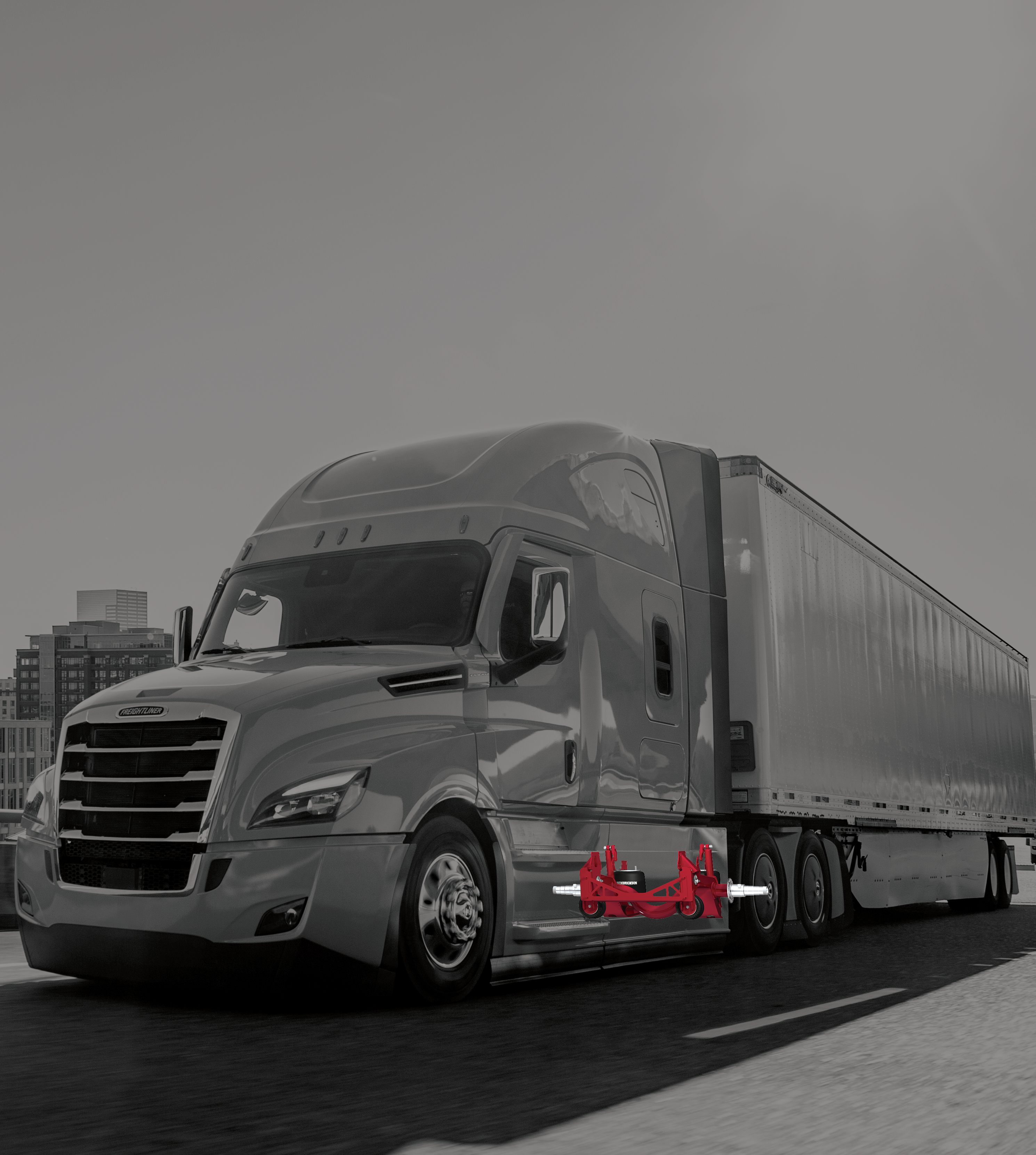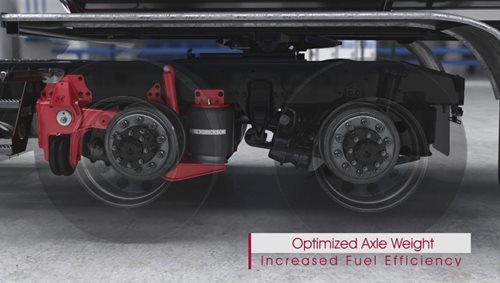
For years I have been a big supporter of the 6x2 axle configuration. A 6x2 axle configuration simply means only one of the two axles on a semi-truck has power directed to it to propel the truck down the road. There are many advantages to a 6x2 axle arrangement. The first advantage to a 6x2 tractor is less parasitic drag due to the elimination of a power divider, intermediate drive shaft and differential assembly. Less parasitic drag leads to increased fuel efficiency along with more available engine horsepower to move freight down the road instead of simply moving parts. A 6x2 tractor is also approximately 400 lbs. lighter in tare weight to a similarly equipped 6x4 tractor. A lighter tare weight is especially important to bulk haulers where every pound of tare weight counts.
A similar set up to a 6x2 tractor is a 8x4 tractor, where there are four axles under its chassis. The 8x4 axle configuration is very common in heavy haul application where there is a need for additional axles to be able to transport heavier loads. The 8x4 equipped tractor typically has a steering axle followed by a liftable pusher axle and then two more axles which are driven.
So why doesn’t heavy haul use three drive axles (tridem) in their world? First of all, heavy haul trucks only need the extra weight carrying capacity of the three axles below the fifth wheel when there is a load that requires the extra capacity the extra axle affords. When a heavy haul tractor is empty, or it is transporting a load that does not require the extra carrying capacity, they simply raise the axle off the ground. The reason this axle is called a liftable pusher is due to its location ahead of the drive axles. The advantages to having the axle lifted in a four-axle configuration is tire wear due to the massive amounts of tire scrub found in a tridem axle followed by fuel efficiency and maneuverability.
When most people think of a 6x2 tractor the first thing that comes to mind is tag axle configuration. On a 6x2 tag axle equipped tractor there are three axles... first there is the steer axle followed by a drive axle and finally a non-driven axle that many refer to as a dead axle. The last axle known as a dead axle is in fact not dead at all! The 6x2 tag axle carries weight in the same way a trailer axle does.
I have personally operated three tractors outfitted with a 6x2 tag axle setup. The 6x2 axle configuration gets a black eye from many people for being hard on drive tires along with having a traction deficit. These shortcomings are somewhat true but not 100% true. It is true that the tires on the driven axle of a 6x2 tag axle does indeed wear out quicker than we are accustomed to compared to a 6x4 configured tractor. Keep in mind this is only on the driven axle. The drive axle tires will have approximately half the life of a typical 6x4 axle configuration.
On the flip side of this issue is longer tire life on the tag axle due to it having the simple function of only carrying weight and not propelling the tractor and trailer. The solutions that I found for managing the tire wear issues on a 6x2 tractor are:
- Starting out with tires designed for use on a trailer. Trailer tires are designed to wear properly in a free rolling application.
- Using the drive axle to make tires for the tag axle and trailer. I found that if I pulled driven axle tires at 8/32nds and moved them to a free rolling application on the tag or trailer axles they wore like iron. Another benefit of this strategy was it kept fresh tires on my drive axle which needed to have the most traction.
Now let us address the traction deficit. You have to be mindful of where and how you drive a 6x2 configured tractor because if you stop with the one and only drive axle in a low spot, there is risk of not having enough traction to start moving again. What I found was that by watching the ground in the same way you would for height or width of the area to be navigated, most problems were adverted. The upside of the lack of traction was better handling in slippery conditions. I discovered that once the truck was moving, the 6x2 tag axle configuration did not try to kick out from under you because the back tag axle tires were simply rolling along without power being directed to them. With the rear two tire positions rolling along freely; it allowed the tag axle to act somewhat like a rudder which kept the truck extremely stable in slippery roadway conditions.
On a side note it is worth noting that the bus/coach market almost exclusively employs the 6x2 axle arrangement. In the case of a bus their cargo is humans, so you can rest assured there is not a safety drawback to a 6x2 tag axle.
Now let us move up to today’s 6x2 axle offering from Freightliner and Hendrickson under the name OPTIMAAX, which is a 6x2 liftable pusher axle configuration. This system was designed to amplify the advantages of a 6x2 while addressing the shortcomings of this fuel-efficient axle arrangement.
OPTIMAAX/Freightliner offers a fully integrated 6x2 axle configuration that has been engineered to have the same ride and handling characteristics as the Airliner rear suspension which is the standard rear suspension on the Freightliner Cascadia. Special attention was put into the OPTIMAAX system to ensure that it works with all the current systems employed in the Detroit Assurance suite of safety systems. OPTIMAAX is a no compromise solution to truck operators who want/need a light weight highly fuel-efficient tractor.
Traction issues have been addressed by utilizing an electronically controlled air suspension which shifts weight to the driven axle when wheel spin is detected. OPTIMAAX also eliminates the worry of overloading a steer axle by automatically lowering the pusher axle when needed. If needed, you also have a differential lock to assist.
Benefits of the OPTIMAAX/Freightliner system are as follows:
- Increased fuel economy thru reduced parasitic drag of a power divider, inter axle shaft and one less ring and pinion to turn.
- Increased fuel economy, with lighter loads, by lifting the pusher axle when it is not needed to support the load.
- Lower tare weight which affords the operator up to 400 lbs. of extra payload.
- Reduced tolls when the pusher axle is in the lifted position.

In my opinion, the idea off lifting axles off the ground when not needed is just good old-fashioned common sense. This approach of lifting axles when not needed has been employed for years with dump trucks, tow trucks and heavy haul trucks. So, this is a sound and proven approach to maximum efficiency.
Let us take this one step further because the aviation industry also employs liftable axle technology. When most aircraft leave the ground, they retract their wheels and landing gear. In the aviation world the landing gear is lifted for the same reason it would be lifted with a tractor equipped with the OPTIMAAX/Freightliner 6x2 liftable pusher axle system which is, reduced parasitic drag. Of course, the airline industry is trying to reduce aerodynamic drag by tucking away its landing gear, but the end reason for having a liftable axle remains the same.
Here is a short list of possible operations which can benefit from the OPTIMAAX/Freightliner 6x2 liftable pusher axle configuration.
- Weight sensitive bulk haulers
- Operators who only need five axles on the ground occasionally
- Tanker trucks
- Toll road users
- Operators who want maximum fuel mileage regardless of the payload